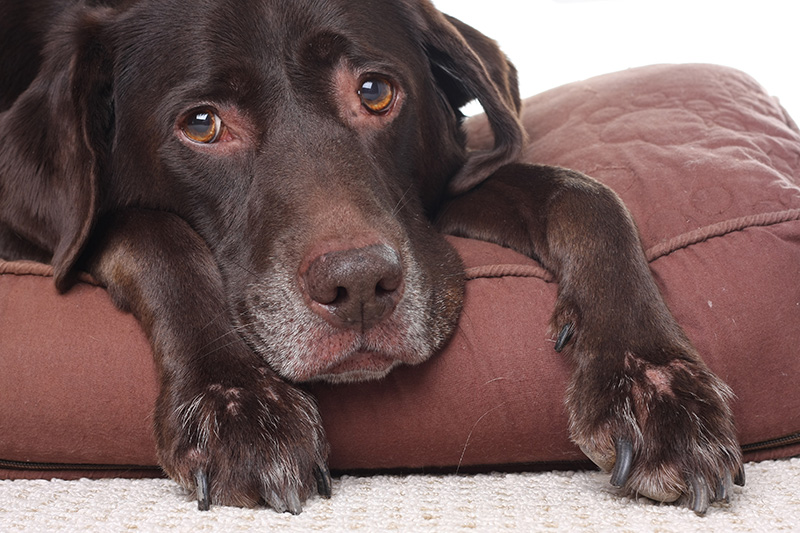New RVC study into euthanasia of dogs aims to help veterinary professionals and owners better prepare for that toughest decision
Research from the Royal Veterinary College (RVC) has revealed new information relating to the euthanasia of dogs – a topic that many owners will sadly face sooner or later for their beloved pet.
Dogs can die via natural causes, but many owners opt to protect their dogs from suffering by choosing to put them to sleep painlessly before this point. However, this is often the toughest decision in the lives of many owners. Given that so many owners face these euthanasia decisions every year, the discoveries in this new study can support veterinarians and owners to better prepare for and come to terms with such difficult decisions.
Led by the RVC’s VetCompass programme, this is one of the largest ever studies using anonymised veterinary health records to understand how dogs die in the UK. The study analysed information from 29,163 dogs that died over a one-year period. This enabled varying causes of death to be assessed simultaneously to evaluate their relative impacts on the decision-making that leads owners to opt for euthanasia compared with an unassisted death.

For the vast majority of UK dog owners, it falls to them and their veterinarian to make the difficult, but often the ultimately caring, decision to put their dog to sleep. Overall, 26,676 (91.5%) of deaths involved euthanasia, whereas only 2,487 (8.5%) of deaths were unassisted.
Amongst the findings, it was indicated that certain types of diseases and conditions were more likely to lead to death by euthanasia. Using cancer as the baseline, the conditions that were more likely to lead to euthanasia included spinal cord disorder and inappetence, as well as poor quality of life and undesirable behaviour. ‘Quality of life’ describes the overall mental and physical wellbeing of the dog and the timing of euthanasia requires deep consideration by the owner as quality of life declines. ‘Undesirable behaviours’ encompass a range of behaviours that owners consider unwelcome, such as severe aggression and advanced dementia. In the case of undesirable behaviour, euthanasia is recommended as a last resort.
Larger bodyweights, increasing age and certain breeds of dog were also additional risk factors for euthanasia. Rottweilers were more likely to die by euthanasia compared to Labrador Retrievers as the standard baseline breed. In contrast, breeds such as Bulldogs, Pugs and West Highland White Terriers were more likely to have unassisted deaths, and these deaths were more likely caused by traumatic injury, foreign body and heart disease.
Additional key findings from the study include:
- The average age at death of euthanased dogs (12.1 years) was older than the average age of dogs that died unassisted (9.9 years).
- Increasing age at death (years) was associated with increased risk of euthanasia relative to unassisted death, with dogs aged ≥ 15 years showing 5.9 times the risk of euthanasia compared with dogs aged < 6 years.
- Bodyweight (kg) was associated with euthanasia, with dogs weighing 20 to < 30kg at 1.24 times the risk of euthanasia compared with dogs < 10 kg.
Successive dog ownership means that many owners endure the loss of several dogs during a typical human lifetime. Regardless of how a dog dies, the loss of a pet can be particularly distressing for owners. Veterinarians describe euthanasia as “the best and the worst” of their clinical role. Understanding more about the levels and reasons for euthanasia in dogs may help owners deal with these tough decisions.
Camilla Pegram, VetCompass™ Epidemiologist at the RVC, and author of the paper, said:
“End-of-life discussions between veterinarians and owners can be particularly difficult for both parties. This study provides benchmark data for the relative proportion of deaths that involve euthanasia and for the relative impact from demographics and disorders on euthanasia decision-making. Owners and veterinary professionals may find it easier to discuss end-of-life options, to reach a final decision and be comfortable with these decisions based on a feeling of broader support from the reported actions of others in similar situations.”
Dr Dan O’Neill, Senior Lecturer, Companion Animal Epidemiology, at the RVC, and co-author of the paper, said:
“The decision for many animal owners to put a beloved dog to sleep is often the hardest decision of their life. The moment of euthanasia often lives with owners forever. Hopefully, the information from this study can at least help some owners come to terms with the responsibility of helping their dog go with dignity. Understanding that over 90% of other owners also opted for euthanasia may help anyone struggling to make this final and hardest decision.”
Dr Carol Gray, Research Associate at the University of Liverpool and co-author of the paper, said:
“Decision-making around euthanasia is shared between veterinarian and owner, although it is the owner who must give consent for euthanasia. Providing this final authorisation is potentially a burden for owners. This paper will help to ease that burden by allowing veterinarians to provide reassurance that they are not the only dog owners to make a decision for euthanasia in similar circumstances.”
Bill Lambert, Head of Health and Welfare at The Kennel Club, said:
“Losing a dog is heart-breaking and having to make the distressing decision to have a much-loved pet put to sleep can seem impossible for some owners. We hope this research, funded in part by The Kennel Club Charitable Trust VetCompass grant, helps to improve dog welfare and supports owners to have those difficult conversations with their vet about their dog’s quality of life, especially if age or illness is impacting on their day-to-day happiness and health.”
Research reference
Pegram et al. (2021) “Proportion and risk factors for death by euthanasia in dogs in the UK”, Scientific Reports www.nature.com/articles/s41598-021-88342-0
Notes to Editors
For more information please contact:
- Jasmin De Vivo (Jasmin.DeVivo@plmr.co.uk or rvc@plmr.co.uk
- Press Line: 0800 368 9520
About the RVC
- The Royal Veterinary College (RVC) is the UK's largest and longest established independent veterinary school and is a Member Institution of the University of London. It was the first in the world to hold full accreditation from AVMA, EAEVE, RCVS and AVBC.
- The RVC is ranked as the top veterinary school in the world in line with the QS World University Rankings by subject, 2021.
- The RVC offers undergraduate and postgraduate programmes in veterinary medicine, veterinary nursing and biological sciences.
- In 2017, the RVC received a Gold award from the Teaching Excellence Framework (TEF) – the highest rating a university can receive.
- A research led institution with 79% of its research rated as internationally excellent or world class in the Research Excellence Framework 2014.
- The RVC provides animal owners and the veterinary profession with access to expert veterinary care and advice through its teaching hospitals and first opinion practices in London and Hertfordshire.


